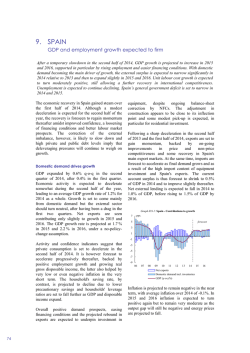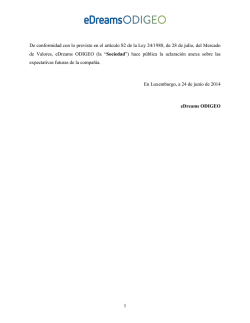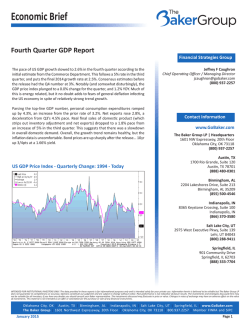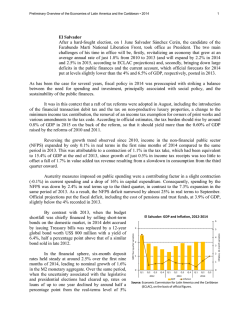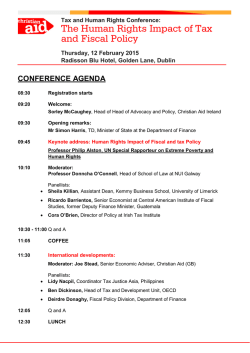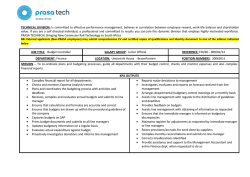
Download PDF version - Economic and Political Weekly
PUBLIC SECTOR Can the Public Sector Revive the Economy? Review of the Evidence and a Policy Suggestion R Nagaraj The public sector’s share in domestic output has stagnated since the late 1980s, its share in capital stock has fallen since 1990, and employment has contracted by 10% from the mid-1990s. Why has it fared so poorly even as its financial performance has improved? This paper argues that fiscal orthodoxy has throttled government borrowing for investment, and competitive politics has disallowed rational pricing by public utilities and recovery of user charges. If these constraints are relaxed by suitably adjusting fiscal deficit targets to accommodate the rise in input costs, and the prices of public utility services are adjusted for inflation, the public sector can revive the economy. Growing public sector enterprises with financial surpluses could also accommodate some political-economic demands. R Nagaraj ([email protected]) teaches at the Indira Gandhi Institute of Development Research, Mumbai. Economic & Political Weekly EPW JANUARY 31, 2015 vol l no 5 I n 1990-91, just before liberal economic reforms were initiated, the public sector accounted for a quarter of India’s gross domestic product (GDP), employing 19 million workers. Administrative departments constituted about 40% of it, the rest came from goods and services produced by department and non-department enterprises (nDes) (following the National Accounts Statistics classification). Though the public sector’s contribution to national development is well acknowledged, inadequate financial return is its widely accepted drawback. The public sector’s burgeoning financial losses were said to be responsible for the rising fiscal deficit on the road to the economic crisis of 1991. The industrial policy statement tabled in Parliament in July 1991 seeking to initiate the structural adjustment programme said as much. India’s severely constrained budgetary circumstances create both the need and opportunity for rationalising the scope of public sector activity, and for placing greater reliance on the private sector for resource mobilisation and investment. Public enterprises have absorbed large amounts of budgetary support for their expansion or operations, but in many cases they have failed to generate adequate returns on the investment of public money and contributed significantly to the public sector saving gap and fiscal deficit (RBI Bulletin, April 1992: 789; emphasis added). Expectedly, imposition of fiscal deficit targets – that is, restricting government borrowing regardless of its purpose – led to a contraction of public investment; disinvestments and privatisation have gradually eroded public ownership and control.1 With industrial deregulation, private (including foreign) firms have entered most sectors – including defence – undermining the strategic role of many public sector enterprises (PSEs) in charting a self-reliant development path. The Fiscal Responsibility and Budget Management (FRBM) Act, 2003 has legally binding restrictions on fiscal deficit – to restrain democratically elected representatives from resorting to fiscal irresponsibility. Notwithstanding the increased managerial freedom granted to many financially well-run central PSEs (designated Maharatna and Navratna enterprises), they have become hostage to short-term budgetary management tactics, as exemplified by the demand of many finance ministers for a “special dividend” from profit-making PSEs to meet the fiscal deficit. This has made a mockery of PSEs’ financial freedom.2 Was the statement placed in Parliament on public sector performance factually correct? No, it was not. Using a widely accepted methodology, Nagaraj (1993) shows how PSEs’ financial losses were a small and declining proportion of the fiscal 41 PUBLIC SECTOR 1 The Trends Output, Employment and Capital Stock In 1960-61, the earliest year for which official estimates are available, the public sector’s share in GDP was about 10% (Figure 1). In less than two decades, the share rose by two and half times, while domestic output grew annually at 3.7%.3 In the two decades after 1990-91, the relative proportions of public administration, and production of goods and services 42 (consisting of department and nDes) have roughly remained constant (Figure 2). It means the stagnation in output share has affected both segments of public sector output equally. Figure 1: Public Sector’s Share in GDP (1960-61 to 2012-13) Per cent of GDP 30 20 10 2012 2009 2009 2003 2006 2007 1997 2000 2005 1991 1994 1988 1982 1985 1976 1979 1970 1973 1967 1961 1964 0 Year ending Source: National Accounts Statistics, various issues. Figure 2: Composition of Public Sector Output (1981-2013) 70 Goods and services 60 50 % Public administration 40 30 20 2013 2011 2003 2001 1997 1999 1995 1991 1993 1989 1987 1985 0 1981 10 1983 deficit – suggesting that most of the fiscal deficit was on account of the government itself. Further, budgetary support for public enterprises was declining, while the productivity of public investment was improving. Examining long-term trends in the public sector, Nagaraj (2006) demonstrates a steady improvement in its financial performance over the last three decades, which holds true even excluding the contribution of financial enterprises (mostly banks). However, despite a steady improvement in the physical indicators of performance, public utilities – electricity, railways, and road transport – are making losses mainly on account of underpricing their output, and the government’s inability (or unwillingness) to collect user charges for the services rendered. The economic boom in the last decade (2003-08) witnessed a fresh assault on the public sector. Contraction in public investment (to meet the fiscal target set by the FRBM Act) went hand in hand with unqualified support for public-private partnerships (PPPs), allowing them easy bank credit and abundant foreign capital to take advantage of lower international interest rates – ignoring their potential currency and maturity mismatch. The public sector’s share in GDP, therefore, plummeted to 20% by 2008-09, an unprecedented decline of 5 percentage points in five years. However, as the boom went bust after the global financial crisis, the private corporate sector floundered, contracting investment demand, and affecting the banking sector with burgeoning bad debts (Nagaraj 2013). However, stepping up public spending as a stimulus to overcome the crisis turned around the output share of the public sector. Thus, after more than two decades of economic reforms, in 2012-13, the public sector’s share in GDP stood at 23% (2 percentage points less than in 1991), employing 17 million workers (two million less than in 1991). The share of department and non-department enterprises in total public sector output has roughly remained the same, though the public sector’s share in the national capital stock has perceptibly declined. Mired in deep debt, the private corporate sector is now in no position to boost investment, and this paper asks if the public sector can step in to revive the economy and overcome industrial stagnation. To answer the question, Section 1 summarises the main trends in public sector output and financial performance, mainly using National Accounts Statistics data. Section 2 offers an explanation for contradictory movements in the public sector’s physical and financial performance, and Section 3 concludes by offering suggestions on how resources can be secured for stepping up public investment. Year ending Source: National Accounts Statistics, various issues. In the economic reforms literature, the public sector’s role in traded goods is widely criticised as they do not claim to serve any particular social purpose. This can be better served by private agents. Governments are often advised to use their limited resources for providing services that the private sector cannot adequately supply, provide goods and services with a public goods character (such as infrastructure), or concentrate on activities that the state alone provides, such as universal primary education and public health. Did the economic reforms manage to alter the sectoral composition of public sector output in the desired direction? The manufacturing sector’s share went down from 45% of the public sector’s output in 1995-96 to 25% in 2011-12. No increase in the share of infrastructure is discernible – it has also declined. Further, there is ample evidence to show that the reforms failed to increase public expenditure (as a proportion of GDP) in education and health (Vijay Shankar and Shah 2012). Therefore, what the reforms have managed to accomplish is shrink the public sector’s role in the economy, rather than reorient it on the lines expected in the analytical discourse. Public employment rose from seven million in 1960 to 20 million in 1997; public administration (combined for all levels of the government) accounted for about two-thirds of it, and quasi-government organisations for the rest of it (as per the Directorate General of Employment and Training classification). By 2011, however, employment fell by two million workers or 10%, most of it in the central and quasi-government segments (Table 1, p 43). Yet, the composition of public sector employment has remained roughly the same during the last three decades, implying that the decline in employment is JANUARY 31, 2015 vol l no 5 EPW Economic & Political Weekly PUBLIC SECTOR equally shared between the government and its enterprises (Figures 3 and 4). Table 1: Public Sector Employment, 1997-2011 (00,000 people) 1997 2011 Decline % Total Central Govt State+Local Govt Quasi Govt 195.59 175.48 20.11 –10.3 32.95 24.63 8.32 –25.3 97.29 92.69 4.6 –4.7 65.35 58.14 7.21 –11.00 Financial Performance Source: Economic Survey, various issues. Figure 3: Public Sector’s Share in Industry and Infrastructure 50 Industry 30 Infrastructure 20 10 1991 1992 1993 1994 1995 1996 1997 1998 1999 2000 2001 2002 2003 2004 2005 2006 2007 2008 2009 2010 2011 2012 2013 0 Year ending Source: National Accounts Statistics, various issues. Figure 4: Public Sector Employment (1991-2011) 100 State and local government Figure 6: Public Sector Savings Quasi government 6 4 Central government 40 20 2011 2010 2009 2008 2007 2006 2005 2004 2003 2002 2001 2000 1999 1998 1997 1996 1995 1994 1993 1992 1991 0 Source: Economic Survey, various issues. 0 -2 Public authorities -6 What about capital stock? As the public sector was initially made responsible for most capital-intensive activities – be it multipurpose dams or power generation – it accounted for a growing share of the nation’s capital stock. In 1980-81, at constant prices, the earliest year for which official estimates are available, the public sector constituted 41% of the economy’s capital stock. The share went up to 53% in 1988-89, but declined thereafter to just 30% by 2011-12 – a clear reflection of the state’s withdrawal from production of goods and services after the reforms (Figure 5). This did not, however, mean a fall Figure 5: Public Sector’s Share in Net Fixed Capital Stock 60 2 -4 Year ending Total public sector Year ending Source: National Accounts Statistics, various issues. NDEs consist of financial enterprises and non-financial enterprises. Non-department financial enterprises (NDFEs) include public sector banks and financial institutions, including the Reserve Bank of India (RBI). However, the bulk of public investments were under non-department and non-financial enterprises (NDNFEs). A disaggregation of NDEs’ savings into its constituent parts shows that it is financial enterprises that have steady savings as a proportion of GDP. Non-financial enterprises’ savings declined to 1% of GDP by 2012-13 from a high of 2.5% reached during the economic boom (Figure 7). Figure 7: Public Sector Savings – Disaggregated 3 EPW JANUARY 31, 2015 2013 2012 2011 2010 2009 2008 2007 0 2006 2011 2009 0.5 Year ending Source: National Accounts Statistics, various issues. Year ending Source: National Accounts Statistics, various issues. Economic & Political Weekly 2007 2005 2003 2001 1999 1997 1995 1993 1991 1989 1987 1985 1983 1981 0 NDFEs saving 1 2005 Public admin 10 2004 20 2 1.5 2002 30 NDNFEs saving 2.5 2001 Per cent of GDP mp Enterprises 2000 40 2003 50 % Public sector saving Non-dept enterprises 60 1991 1992 1993 1994 1995 1996 1997 1998 1999 2000 2001 2002 2003 2004 2005 2006 2007 2008 2009 2010 2011 2012 2013 Persons in lakhs 80 Is this account of the public sector warranted by its financial performance? Figure 6 plots public sector saving-to-GDP ratio since 1990-91, disaggregated by administrative departments (ADs) and NDEs. ADs repre- Table 2: Growth in Real Capital Stock sent saving in the revenue in the Economy and in the Public Sector, 1981-2012 (% per year) account of the budget (com- Years Total Public Sector bined for the centre and 1981-2012 6.2 4.2 states), and NDEs constitute 1991-2012 7.0 3.9 the enterprises. Evidently, 1999-2012 8.2 4.9 the public sector’s dissaving Source: National Accounts Statistics, various issues. came down in the last decade, as the fiscal balance improved, but deteriorated after the financial crisis as a fiscal stimulus, as a countercyclical measure, was induced to prevent further deterioration of economic performance. However, NDEs have maintained a modest and reasonably steady positive saving rate since 1991 at between 3% and 4% of GDP. Per cent of GDP mp Per cent of GDP 40 in the growth of the economy’s capital stock as private investment increased. Capital stock growth has accelerated over the decades (with a rising fixed investment to GDP ratio), though the public sector’s share in it has declined (Table 2).4 vol l no 5 43 PUBLIC SECTOR As the NDNFEs include PSEs owned and managed by the central government, as well as utilities such as electricity boards and road transport corporations, we try to make a further disaggregation to identify the sources of poor financial performance. Profitability of central PSEs (simply PSEs hereafter), defined as the ratio of gross profits to gross capital employed, has gradually moved higher (Figure 8). This is true even after netting out petroleum sector enterprises, whose administered prices include a sizeable element of taxation. If the foregoing disaggregation of public sector performance is correct, then it can be inferred that public utilities have performed poorly. Though not a startling finding, it is perhaps definitive evidence of where exactly the problem of poor financial performance lies. Figure 8: CPE’s Profitability 25 20 CPE’s profitability % 15 10 CPE’s profitability net of petroleum firms 5 2010 2007 2004 2001 1998 1995 1992 1989 1986 1983 1980 1974 1977 0 Year ending Source: Survey of Public Enterprises, various issues. These losses are widely discussed in public and academic discourse as evidence of the inefficiency of public ownership, which requires urgent reforms. But what is not adequately appreciated is that the prices charged by the government for these services (administered prices) do not cover the costs. Figure 9 plots the ratio of public sector deflator to GDP deflator; the electricity deflator to GDP deflator; and the railway deflator to GDP deflator over the last two decades. Evidently, all the three relative prices (or real prices) have steadily declined since 1990-91, implying that the prices of these services have risen at a slower pace than the general price rise. In other words, the output prices of electricity and railways, in particular, have fallen relative to the general price rise. In principle, if such a decline represents improvements in output growth (after meeting all costs), it would signal a productivity boost. But, alas, the shortfall reported in the graph represents poor revenue growth, on account of underpricing and non-recovery of dues from users. 140 Elec deflator/GDP deflator 120 PS deflator/GDP deflator Ratio 80 Railway deflator/GDP deflator 60 40 20 44 2013 2012 2011 2010 2009 2008 2007 2006 2005 2004 2003 2002 2001 2000 1999 1998 1997 1996 1995 1994 1993 1992 1991 0 Year ending Source: National Accounts Statistics, various issues. 2 What Explains Public Policy? The analysis demonstrates that an unhelpful, if not adverse, policy environment has dented the public sector’s financial performance, damaging public investment and technical progress. Why have policymakers undermined the sector despite its steadily improving financial performance? A widely held view attributes this to embracing neo-liberal reforms, which keeps the fiscal deficit very low to please the financial markets (and rating agencies) on which India increasingly depends for financing its current account deficit. While the argument merits attention, can it be the sole or primary explanation for the observed declined in relative prices of public sector output? Probably not, for the simple reason that increasingly competitive electoral politics have compelled policymakers to resort to market-based solutions even while knowing their limitations and long-term adverse consequences. Once again, the railways seem to be emblematic of how the competitive politics of patronage has decimated the world’s largest rail network. The urban population, often mobilised by political parties regardless of their ideology, has violently opposed hikes in railway fares. Sensing the electoral mood, in coalition politics, political executives have resisted unpopular decisions. In other words, it is the short-termism of politicians that has ruined the railways. Bureaucracy, as often is the case, plays along with its political masters by window dressing accounts, the reality of which will come to light (if at all) only years later. Populist ministers have probably damaged the railways for more than the ideology of neo-liberalism. So, one has to seek a political economic explanation for the deterioration of the public sector. K N Raj was perhaps prescient when he observed in 1985 that no political group has emerged that will defend the public sector in the interests of the future. To quote him, While there has been much verbal support for public enterprises (on conventional as well as radical grounds), perhaps the most important reason why they have not been able to grow, in the manner once hoped and expected, was simply that there has not emerged any political force in the country generally interested in making such enterprises yield adequate profits and savings on their own. Irrespective of the labels displayed they have been in effect coalitions of various kinds treating public sector as a milch cow for serving narrow sectarian interests. Figure 9: Ratio of Price Deflators 100 The problem is perhaps best illustrated by the railways, whose prices declined by as much as 39% since 1990-91 (relative to general prices) as the administered prices did not keep pace with inflation. This starved it of much-needed revenues, compelling it to seek budgetary support. A simple computation suggests that if railway fares had kept pace with the wholesale price index (WPI), in 2011-12, the additional revenue would have not only covered its financial losses, but also more than met the budgetary support provided for capital investment. Why have the “intermediate classes”, which, according to Raj, were the primary force behind the growth of the public sector given up on it as a means of self-advancement? Urban professionals, the salaried class, and the rural rich, who gained the most from the expansion of the public sector in the JANUARY 31, 2015 vol l no 5 EPW Economic & Political Weekly PUBLIC SECTOR early post-Independence period, do not seem to need it as a crutch after liberalisation. Having acquired the necessary capital and skills to become “global Indians,” they have joined the world elite to secure better returns for their human capital (acquired by highly subsidised higher education) across continents, currencies, and markets, leveraging their mobile factors of production (Freeland 2011). But large masses of Indians who lay just below the globalised “intermediate classes”, who should, in principle, be the potential defenders of their class interest, also do not seem to find the public sector useful any more as they seem to be caught in a game of competitive politics, organised on the lines of caste, region, ethnic loyalty, and patronage. They hope to secure individualised gains from a plethora of sub-optimal government welfare programmes, however meagre they might be. And what about the large landowners and regional elites? The time horizons of their political calculations seem to have shortened, and their pragmatic use of the public sector seems to be almost entirely driven by electoral calculations. This can perhaps be well illustrated with an example from Uttar Pradesh. All political formations during the last two decades have privatised state-level public enterprises, apparently at a considerable loss to the exchequer (Bajaj 1994). Yet they have all opposed privatisation of the loss-making Scooters India, a central government enterprise in Unnao, near Lucknow, on ideological grounds. They have argued that the plant should be revived with further investment – evidently to extract financial largesse from the central government (without any consideration for the potential economic viability of such public investment). It only goes to substantiate what Pranab Bardhan observed in an expanded edition of his monograph, Political Economy of India, where he said, Along with political power drifting from the centre to the regions, there is an associated drift towards the backward and lower castes. This is clearly a sign of democratic progress in an unequal society. The numerical strength and increased assertiveness of some of the historically subordinated groups have compelled the upper classes and castes to form downward alliances and brought to the fore political actors from backward communities and regions. These players may be uninitiated in the etiquette of parliamentary democracy and in the social graces of modernity, but are quite astute in pursuing the interest of their constituencies (and, of course, their own self-interest) (1998: 132). In the light of this, one is compelled to believe that the undermining of the public sector is not merely or principally the outcome of liberal ideology. Competitive politics is equally responsible. Therefore, is the decline of the public sector “as we know it” inevitable? Probably not, if one can discern the pulls and pressures of demands for development at the micro level across the country. The very fact that the public sector’s share in domestic output has broadly held up even after two decades of reforms (contrary to many dire predictions) seems to suggest some deeper forces are at work, which can be hypothesised as follows. Given the abysmal material conditions of the masses, the Economic & Political Weekly EPW JANUARY 31, 2015 vol l no 5 public sector is likely to remain a vital agency of state policy for many pragmatic reasons. For instance, the recent, muchacclaimed Bihar growth story is mainly a tale of success of public investment in roads and bridges spearheaded by statelevel construction companies after devastating floods in the middle of the last decade. Economic development of the northeast region is perhaps almost entirely the result of public sector efforts, which have taken on the risks and uncertainties of initiating large investment projects in a politically hostile territory with the help of substantial fiscal transfers. If the ideologically inclined elites seem bent on shrinking the public sector, the poor material conditions of the masses, in a deepening democracy, seem to necessitate its expansion (or at least to thwart its quick decimation) to deliver developmental needs even in an imperfect manner. But the critical factor in this balance of forces is the constraint imposed by the FRBM Act. These budgetary rules have effectively shut the government’s (more so at the state level) ability to expand public investment, and instead seek private and foreign investment – at least to be seen to be doing something. Escrow accounts have guaranteed priority payment for private investors, overriding the interests of all other stakeholders. Perhaps public sector finances can be retrieved by modifying the budgetary rules to provide for a near automatic adjustment for rises in input prices of principal inputs such as diesel for road transport corporations, or coal, gas, or wages for electricity (say, up to 90%). In other words, fiscal deficit targets should be made contingent on an adjustment for a rise in input costs, or the PSEs should be granted the financial freedom to borrow an equivalent amount over and above the fiscal deficit. Thus, we contend that if there is one reform that can mute a lot of criticism against the public sector and dispel the popular perception of it “surviving on subsidies”, it is pricing reform. Just like oil refineries were last year allowed to pass higher crude prices on to consumers, the prices of domestic PSEs using oil, such as the railways and road transport operators, should be indexed to diesel prices. As a matter of principle, public sector prices should be linked to the WPI and real GDP growth. Indexation of public sector prices could also be linked to withdrawal of budgetary support after adjusting for the cost of meeting social responsibilities. However, complete indexation will bring in (and bring back) the “cost plus” pricing principle with all its adverse consequences. For instance, Indian Telephone Industries, Bengaluru, the captive telecom equipment manufacturer, was sheltered by cost plus pricing and had no incentive to develop technical competency. It lost out when it was faced with competition after deregulation in the 1990s. So there is also a need to build in suitable incentives for an increase in productivity.5 3 Conclusions This study has sought to trace the principal trends in public sector performance, mainly using National Accounts Statistics; explain the divergence in the physical and financial performance of the sector; and suggest ways to expand it, 45 PUBLIC SECTOR which is the way to revive growth and overcome industrial stagnation. The public sector’s share in domestic output has largely remained stagnant since the late 1980s; its share in the economy’s capital stock has declined steeply, and the absolute number of workers employed in it has fallen by 10% since 1997. The public sector no longer commands the heights of the economy, with unfettered private and foreign-owned firms gradually overtaking it after entry barriers were removed. Yet the public sector has not disappeared – at least not yet – as many feared or hoped (depending on one’s viewpoint). While its share in manufacturing has declined sharply, its share in infrastructure has also suffered (contrary to expectations given the public goods nature of many services). The much advocated (and hoped for) rise in the provision of public services has failed to materialise as the ratio of public expenditure to GDP in health and education has not improved. The liberal reforms have, therefore, managed to undermine the development state without replacing it with anything resembling a social democratic alternative. Public sector investment has contracted after the reforms in spite of an improvement in PSEs’ financial performance (contrary to popular and official perceptions). A steady level of savings by NDE s as a proportion of domestic output is clearly discernible. The genesis of public sector reform, it is worth recalling, was its poor return on capital employed. But, ironically, the sector has shrunk, not for lack of improvement of finances, but in spite of it – as evidence gathered in this study demonstrates. With hindsight, it seems reasonable to infer that the reasons for rolling back the public sector were a barely disguised attack on the state-led development strategy. The financial arguments were perhaps mere camouflage. It is hard to deny that the public sector has also been a victim of competitive politics in a deepening democracy. But the development aspirations of those left behind and the need for national cohesion have been compelling reasons for the state to extend its ambit, however reluctantly and unsatisfactorily. Hard budget constraints imposed by fiscal deficit targets and the FRBM Act have succeeded in restricting the public sector, and have failed to compensate it for underpricing utilities and not collecting adequate user charges. Given the constraints, is there a hope of the public sector promoting national development objectives? As we have shown, underpricing of public sector output has had a crippling effect on PSEs, forcing them to seek (much derided) public subsidies. In other words, PSEs have to seek budgetary support as their output is underpriced and dues go uncollected for political reasons. The best way to make PSEs stand on their feet, this study contends, is to peg their output prices to their input prices, say, up to 90%, nudging them to make up the remaining by increasing productivity, and relaxing the fiscal deficit rules to allow more borrowing to offset increased input costs. Given the acute development backlog, there is little option but to depend on the instrumentality of the public sector to meet growing aspirations. Moreover, the current macroeconomic situation increasingly calls for stable, autonomous, public investment to revive output growth. Fiscal rules may be desirable to restrain the political economy from running amok, yet it needs to ensure that the services rendered by the public sector are paid for. Only then will the sector have the economic and political legitimacy, and resources, to further the cause of development. Notes References 1 Bajaj, J L (1994): “Divesting State Ownership: A Tale of Two Companies”, Economic & Political Weekly, Vol 29, No 35. Bardhan, Pranab (1998): Political Economy of India (revised edition), Oxford University Press, Delhi. Freeland, Chrystia (2011): “The Rise of the New Global Elite”, Atlantic Monthly, January/February. Nagaraj, R (2013): “The Dream Run: 2003-08: Understanding the Recent Boom and Its Aftermath”, Economic & Political Weekly, Vol 48, No 20. – (2006): “Public Sector Performance since 1950: A Closer Look”, Economic & Political Weekly, Vol 41, No 25. 2 3 4 5 46 Until then, budgetary deficit – defined as, net RBI credit to central government – was the operational tool. Analytically, it implied that public sector borrowing from the central bank was to be restricted, but the borrowing from the banking sector was not. More realistically, perhaps, PSEs have remained instruments of macroeconomic policy; but its goals have changed with the policy regime. Growth rates reported in the paper, unless otherwise mentioned, are at constant prices. The sharp fall in the share of public capital stock is more severe than what is evident from the reduction in fiscal deficit for the simple reason that revenue deficit (that is, in simple terms, borrowing for current consumption) has remained stubbornly high, between 3% and 4% of GDP. In other words, growth in capital formation falls to the extent that the fiscal deficit is used for current consumption (or meeting the revenue deficit). So the growth in capital stock gets reduced correspondingly. It seems worth mentioning the discussion on public sector pricing in the UK after the Margaret Thatcher regime. It came up with a well-known formula, (RPI-x), that is, the prices of public utilities should be tagged to the retail price index, minus “x”, which should represent the productivity increase. Though the pricing rule was widely criticised, the public discussion apparently helped evolve more rational pricing, reducing budgetary support for enterprises. – (1993): “Macroeconomic Impact of Public Sector Enterprises: Some Further Results”, Economic & Political Weekly, Vol 28, Nos 3-4, 16-23 January. Raj, K N (1985): “New Economic Policy”, V T Krishnamachari Memorial Lecture, Institute of Economic Growth, Delhi. Vijay Shankar, P S and Mihir Shah (2012): “Rethinking Reforms: A New Vision for the Social Sector in India” in R Nagaraj (ed.), Growth, Inequality and Social Development in India: Is Inclusive Growth Possible?, Palgrave Macmillan, for the United Nations Research Institute for Social Development, Geneva. ODISHA April 5, 2014 Persisting Dominance: Crisis of Democracy in a Resource-rich Region – Manoranjan Mohanty Shift from Syncretism to Communalism – Pralay Kanungo Mining and Industrialisation: Dangerous Portents – Banikanta Mishra, Sagarika Mishra Confronting Extractive Capital: Social and Environmental Movements in Odisha – Kundan Kumar Who Does the Media Serve in Odisha? – Sudhir Pattnaik For copies write to: Circulation Manager, Economic and Political Weekly, 320-321, A to Z Industrial Estate, Ganpatrao Kadam Marg, Lower Parel, Mumbai 400 013. email: [email protected] JANUARY 31, 2015 vol l no 5 EPW Economic & Political Weekly
© Copyright 2026
